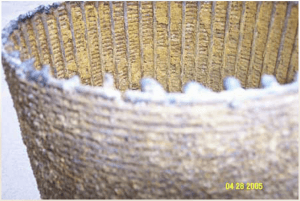All wells will experience performance declines over their lifespans, some wells more rapidly than others. For instance, wells in alluvial deposits, while generally more productive than bedrock wells, tend to be more prone to well performance issues and require more frequent rehabilitation as a rule. The major causes of reduced well performance tend to fall into three major categories as follows:
Filter Pack Plugging: Wells typically have a one way flow of groundwater into the well which, over time, results in the migration of fine-grained material such as silts and clays into the filter pack, the accumulation of which eventually impedes groundwater flow into the well. Smaller sand particles can often form sand bridges for the same reason. All these situations result in increasingly inefficient flow of water into the well and even full plugging of sections of the filter pack in some instances.
 Mineral Incrustations: Depending on the chemistry of the groundwater and well design factors, mineral incrustations can develop on the screen and even in the filter pack. Calcium carbonate, iron and manganese deposits are the most common types of mineral incrustations seen in wells, but there can be other types also. Mineral incrustations can develop as a result of turbulent flow in the filter pack and at the well screen, velocity drops at the well screen and oversaturation of minerals in the groundwater. There is evidence that lower quality screens may be more subject to the development of mineral incrustations as well. Mineral incrustations tend to initially form as a soft gelatinous masses that harden over time.
Mineral Incrustations: Depending on the chemistry of the groundwater and well design factors, mineral incrustations can develop on the screen and even in the filter pack. Calcium carbonate, iron and manganese deposits are the most common types of mineral incrustations seen in wells, but there can be other types also. Mineral incrustations can develop as a result of turbulent flow in the filter pack and at the well screen, velocity drops at the well screen and oversaturation of minerals in the groundwater. There is evidence that lower quality screens may be more subject to the development of mineral incrustations as well. Mineral incrustations tend to initially form as a soft gelatinous masses that harden over time.
Biofouling: It is estimated that biofouling is involved in more than 80% of all well plugging cases. The usual suspect in biofouling situations is iron-reducing bacteria, which grows well in the aerobic zone of the well. Iron-reducing bacteria form a protective biofilm which can often shield the bacteria themselves from straight chemical applications such as chlorine. In the aerobic environment of the well, iron-reducing bacteria can thrive and reproduce to the point where they can completely plug well screens. Many times, sulfur-reducing bacteria can grow under the iron-reducing bacteria and in anaerobic zones of the well. The danger of sulfur-reducing bacteria is less to do with plugging of well screens than that it produces hydrogen sulfide gas which is highly corrosive to the well. Indicators of iron-reducing bacteria are increased iron concentrations in the well water over time and indications of sulfur-reducing bacteria are “rotten egg” odors from the hydrogen sulfide gas. There are other types of bacteria-related performance issues that can arise, so it is important to monitor the total bacteria count in a well over time.
A Note on Open-Hole Bedrock Wells: Open-hole bedrock wells are not immune from developing well performance issues over time. Iron-reducing bacteria can still be an issue. Mineral incrustations usually take the form of deposits which can reduce the size and productivity of the fractures that supply water to the well. Over time, productive factures can squeeze down due to overlying rock pressure, reducing groundwater flow through those fractures. Due to the volumes of water that can pass through the fracture and solution channels in karst areas, silt and clay accumulations can cause plugging to the point where flow is reduced.
Keep in mind that some or all of these problem situations can occur in a well at the same time, so it is important to use proper diagnostic tools to determine the full cause of reduced well performance before deciding on a course of action for well rehabilitation.
